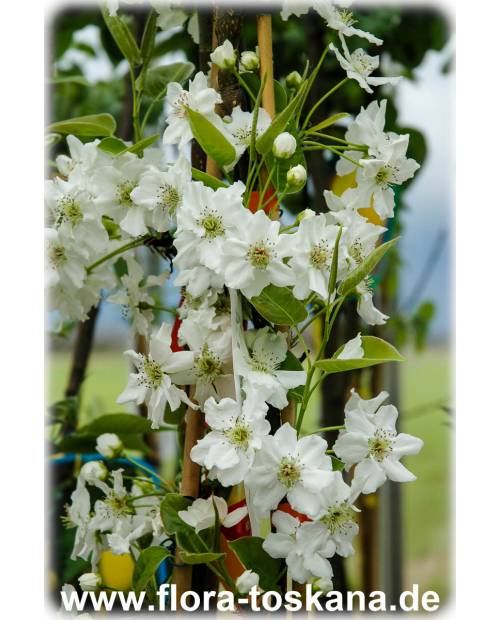Camellia japonica 'Historical Varieties' - Historical Camellias
Camellias of the 19th century - bred in Tuscany between 1800 and 1900, these camellias (Camellia japonica) have been accustomed to the European climate for many years. They bloom well and are hardy even in our latitudes in most locations.
We have found the varieties Koto no Kaori, Dionisia Ponlatowski, Santarelli, Angela Cocchi, Cimarosa, Giuseppina Mercatelli and Rosaeflora for you and added them to our range so that you too can grow these "ancient" varieties in your garden, just as they have grown for centuries in the gardens of villas and palaces in Tuscany and from there have been made available to our partners for reproduction.
Camellias (Camellia japonica), originally native to Japan and China, were first introduced to Europe around 1745, first mainly to England. The spread of these plants took place all over Europe and was strongly promoted a little later, in particular by the novel by Alexandre Dumas the Younger "The Lady of the Camellias" (published in 1848) and the opera "La Traviata" by Giuseppe Verdi (premiered in 1853). In Italy, the first camellias are documented in the Palace of Caserta north of Naples around 1760. This fashion and passion soon spread throughout Italy and in Tuscany, camellias found their place in palaces and villas and later also in the country's courts.
Historical camellias - a real rarity and in the context of annual new breeds a sign of stability and reliability in terms of location suitability and flowering ability. Our historical varieties have been made available to our partners for reproduction from the palaces and villas of Tuscany. In this way, our customers are also able to grow these ancient varieties in their own gardens and enjoy these wonderful old flowers and at the same time be part of a project that keeps these ancient varieties and their genetics alive through propagation.
![]() General information on Japanese Camellia: The evergreen shrubs with the glossy, leathery dark green leaves love semi-shady places and acidic, well drained but moist, humus-rich soil as well as acidic fertilizers (e.g. rhododendron fertilizer). Their thick flower buds are already formed from (late) summer, ripen from about September until flowering in February/March/April at 0 to 10 °C, and open in cool places around 10 °C. If the temperature is too high, the buds will fall off before they open: Japanese Camellias are not houseplants! But they are wonderful winter garden plants, which rightly bear the nickname "Roses of Winter". Or – due to their surprisingly high winter hardiness, depending on the variety – they can be planted out as permanent guests in the garden, protected from the winter sun with a shade net or fleece. When planted in the garden, flowering starts (depending on the weather) a few weeks later than potted Camellia in a conservatory.
General information on Japanese Camellia: The evergreen shrubs with the glossy, leathery dark green leaves love semi-shady places and acidic, well drained but moist, humus-rich soil as well as acidic fertilizers (e.g. rhododendron fertilizer). Their thick flower buds are already formed from (late) summer, ripen from about September until flowering in February/March/April at 0 to 10 °C, and open in cool places around 10 °C. If the temperature is too high, the buds will fall off before they open: Japanese Camellias are not houseplants! But they are wonderful winter garden plants, which rightly bear the nickname "Roses of Winter". Or – due to their surprisingly high winter hardiness, depending on the variety – they can be planted out as permanent guests in the garden, protected from the winter sun with a shade net or fleece. When planted in the garden, flowering starts (depending on the weather) a few weeks later than potted Camellia in a conservatory.![]() Quality: fragrant & red & double & very numerous & peony-shaped flowers; evergreen & glossy leaves; vigorous & bushy growth; good to very good winter hardiness
Quality: fragrant & red & double & very numerous & peony-shaped flowers; evergreen & glossy leaves; vigorous & bushy growth; good to very good winter hardiness
![]() Use: planted in the garden; outdoors in pots from March/April in a semi-shaded place - during winter in an unheated room; all year in an unheated or rarely heated greenhouse
Use: planted in the garden; outdoors in pots from March/April in a semi-shaded place - during winter in an unheated room; all year in an unheated or rarely heated greenhouse
Data sheet
- Family
- Theaceae
- Origin
- Asia (mediterranean)
- Flowering period
- Winter
- Growth
- Shrub
- Location
- Shadow
- winter temperature
- 5 (+/- 5) °C
- Minimum temperature
- -15 °C
- Hardiness Zones
- 8
- Height
- 2 - 2,5 m
You might also like
Customers who bought this product also bought:



















































